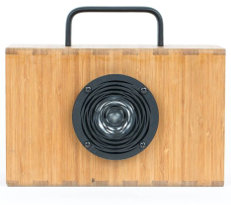A Bluetooth Speaker Powered By A Supercapacitor
November 05, 2014By Lance Powers
There are quite a few companies making portable bluetooth speakers. Blueshift out of Portland, OR is making a different kind. Rather than using a battery to power the speakers, supercapacitors do the job, with some amazing results.
Supercapacitors, like batteries, can store energy. Batteries store energy chemically. Most batteries in electronics and computers (and increasingly in electric cars) use some type of lithium compound as their foundation. Supercapacitors store energy physically in an electric field.

Like everything, supercapcitors have their pros and cons. Unfortunately, they are fairly expensive compared to batteries. They are also fairly bulky. The great things about them are that they can be charged very, very quickly and they can be recharged many, many times.
A typical lithium-ion battery (such as those found in your smartphone, tablet or laptop) has a lifespan of about 1,000 charges before the battery starts to significantly lose it's capacity. Because of this, in an effort to make the battery last as long as possible, the careful (anal?) choose to only charge their devices when needed and to only charge up to 80% capacity and attempt to avoid running the battery below 20%.
Blueshift is using the positive traits of supercapacitors to allow their Hydrogen bluetooth speaker to be fully charged in 5 minutes. It can also be recharged 500,000 times (that's more than a lifetime of service, even if charged every day). Compared to a battery, this is pretty amazing.
The downside of using supercapacitors means that the Blueshift speakers are expensive and the cabinets are fairly large compared to competing battery designs.
Blueshift tries to make up for the negatives in other ways. The cabinets for the Blueshift speakers are made in Oregon out of bamboo, which looks and sounds nice. No plastic parts are used. They're definitely made to last. All the components, including the supercapacitor bank, can be replaced or upgraded. In fact, the entire product is "open" and the electronic design files can be downloaded for future hacking.
Blueshift recently posted on their blog about seven great features of their products that aren't widely known:
- None of their products (PCBs, components, solder) contain lead.
- Only film capacitors are used for audio signal filtering, even though ceramic capacitors are way cheaper, easier to mount and assemble... Ceramic capacitors add distortion.
- All cabinets are sealed internally with silicon and expanding foam because tiny air holes can add distortion.
- They tested over 15 different 3.5mm audio jacks before they found one that was "awesome".
- They use overbuilt, high current inductors for their output filters....because they sound better.
- The speaker grills, handles and control panels are all aluminum, not plastic.
- The speakers actually sound better as they are used...the drivers break in over the first hundred hours.
Quality costs money, but it appears that Blueshift is dedicated to this goal.
Blueshift has a number of other products, including stereo speakers, a subwoofer and a preamp, in case you want to plug in an electric guitar or a turntable.
Image Credit: Blueshift
